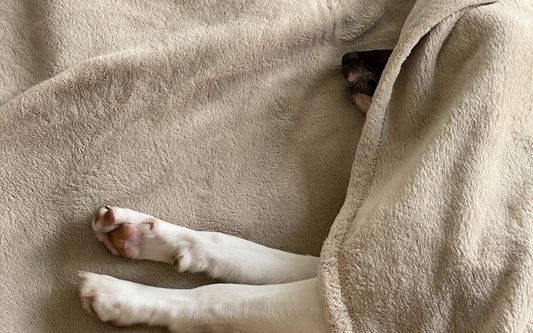Spring has officially sprung and we couldn't be more happy about it! 🌸
As the weather starts to warm up, trees begin to blossom and flowers bloom, there’s no better time to get outdoors and enjoy everything the UK’s spring months have to offer.
Perhaps the only downside to this time of the year is the seasonal allergies that affect 1 in 4 of us in the UK. But it’s not just humans that suffer, dogs can also be susceptible to allergies throughout spring and summer.
If you’ve experienced hay fever before, you’ll know just how itchy and uncomfortable it can be. To prevent your dog from feeling the same, it’s important to understand how to spot hayfever in dogs, and steps you can take to manage your dog’s symptoms.
Dog Hayfever Guide:
- What is hay fever?
- Can dogs get hay fever?
- When do dogs get hay fever?
- Dog hay fever symptoms:
- What can I give my dog for hay fever?
- Can I walk my dog with spring allergies?
- Other ways to manage your dog's hay fever:

What is hay fever?
Hay fever is a type of allergic reaction to pollen particles that come into contact with your eyes, nose, mouth and throat. Also referred to as ‘allergic rhinitis’, hay fever commonly occurs in the spring and summer months when it is warm and windy. The higher the pollen count, the worse hay fever symptoms tend to be.
Can dogs get hay fever?
Yes, dogs can also get hay fever and suffer from pollen allergies throughout spring and summer. When dogs have hay fever, their bodies react to pollen in the air and usually their skin is affected. Unfortunately, there is no cure to dog hay fever, but there are steps you can take to help your pup manage its symptoms.
When do get hay fever?
As with humans, the months your dog is prone to developing hay fever depends on the type of pollen your dog is allergic to. Because of this, it’s important to keep an eye out for symptoms throughout the following months of spring and summer:
March - May: Tree Pollen🌲
A large percentage of people in the UK who suffer from hay fever are allergic to tree pollen. Many varieties of trees are at their peak of releasing pollen through these months, so if your dog suffers in early spring, tree pollen is the likely culprit.
May - July: Grass Pollen 🌱
This type of pollen not only affects hay fever, it can also cause contact dermatitis in dogs and humans, which can cause skin irritation and result in painful itching.
June - September: Weed Pollen 🌿
The UK is home to a number of different plants that create weed pollen. This type of allergy is more prevalent in summer, as weed pollen is more common with sunny days. Whenever you take your pup away on a dog friendly holiday, it's important to consider whether the location will impact their allergies.
Dog hay fever symptoms:
Dogs can suffer hay fever in two ways, through pollen inhalation and skin contact. Because dogs spend a lot of time exploring grassy parks and woodlands, it’s important to be aware of, and keep an eye out for potential hay fever symptoms.
The most common symptom of hay fever in dogs is skin irritation. This is because histamines are released by dogs bodies in reaction to allergens. Histamines are what cause itchiness all over a dog’s body.
What are the symptoms of hayfever in dogs?
- Itching, rubbing or nibbling the following areas:
- Paws and legs
- Eyes, ears and mouth
- Tummy, groin and bum area
- Rashes on paws and legs
- Runny nose and frequent sneezing
- Red and weepy eyes
What can I give my dog for hay fever?
To understand how to treat dog hayfever, it’s important to do plenty of research! As well as this, the best thing you can do to manage specific symptoms is to contact your vet. Trained professionals will be able to give the best guidance for managing allergies and preventing discomfort.
Usually dog hay fever treatment includes targeted solutions, such as eye drops, nasal sprays, ear cleaners and medicated shampoos, sprays and creams. In severe cases, your vet may choose to give your dog an injection to help get the allergy under control.
Important: Human antihistamines are toxic to dogs, so never provide treatment without consulting your vet first.
Can I walk my dog with spring allergies?
Even if your dog is suffering from hay fever, getting enough exercise is still vital. You can still take your dog for daily walks, but you should adjust your normal walking routine to help prevent spring allergies from worsening.
Tips for walking your dog in spring:
- Monitor pollen forecasts each day and try to stay indoors when the count is high
- Because pollen counts tend to be highest at midday, it's better to walk your dog early in the morning or late in the evening
- Dog allergy testing can be used to test for sensitivities in dogs, which can help to identify the specific type of pollen your dog is allergic to. Once you know which pollen is causing your dog’s spring allergies, you can take greater care to manage symptoms during the applicable months:
- Tree Pollen Allergies: Avoid windy and dry dog walks
- Grass Pollen Allergies: Keep your dog on a lead in grassy areas to prevent their fur getting covered in pollen
- Weed Pollen Allergies: Avoid walking in forest areas where weeds usually grow
Other ways to treat your dog's hay fever:
- Always wipe paws, face and skin after walks to remove excess pollen
- Increase the frequency of cooling baths to relieve itching and promote skin hydration
- Regularly wash your dog’s bedding to reduce dander build up
- Consider protective clothing like lightweight dog coats to prevent skin contact
- Use air filtration systems at home to remove aggravating air particles
Does your dog suffer from hay fever?
Comment below to share your top tips for managing allergies at this time of the year:
↓


